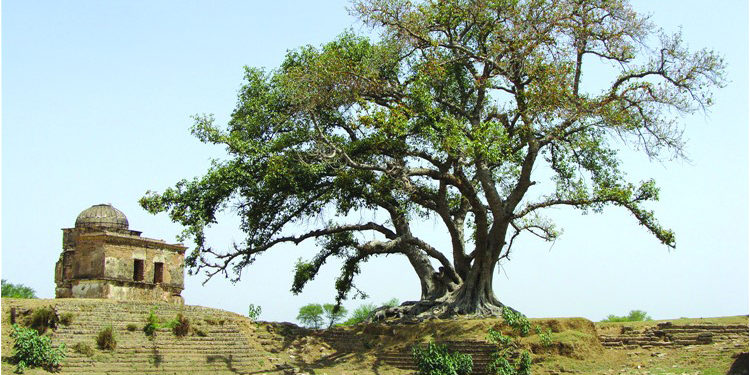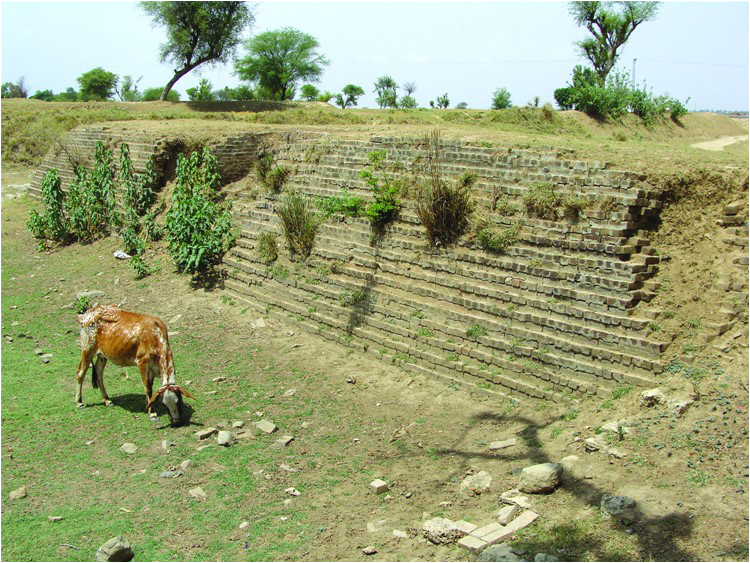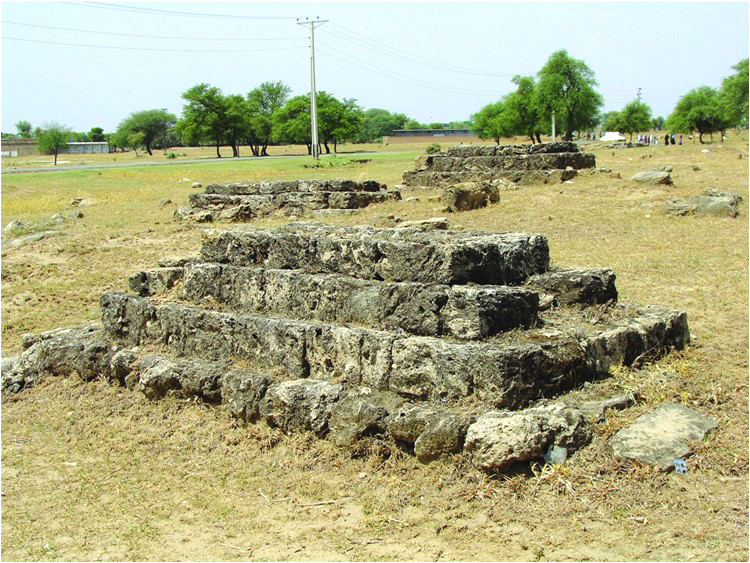
Samadhi of Baba Mohan Das is one of the most popular shrines of an Udasi ascetic of colonial Punjab in Pothohar.
Zulfiqar Ali Kalhoro
Located about 3 km south of Sukho town is the dilapidated Samadhi of Baba Mohan Das, one of the most popular shrines of an Udasi ascetic of colonial Punjab in Gujar Khan Tehsil.
Baba Mohan Das was believed to have been an Udasi saint venerated by both the Hindus and Sikhs of Rawalpindi district. The landscape of the Potohar region in Punjab was once dotted with the samadhis and shrines of Udasi ascetics.
The Udasis trace their spiritual lineage back to Baba Sri Chand (1494-1629), the elder son of Baba Guru Nanak (1469-1539). They were celibate and like the Nath yogis used to establish dhuni and practiced austerities in caves. In fact, there are many caves in Potohar where both Nath and Udasi ascetics practiced tapas. Both were celebrated for the practice of Hatha yoga. Some of the caves at Katas Raj were also used by both the Nath yogis and Udasi saints. Tila Jogian, which was the most famous Nath monastery in Potohar, also attracted ascetics of other religions particularly of Jianism, Buddhism and Sikhism.
After the death of Baba Sri Chand, the guruship of the Udasipanth was transferred to Baba Gurditta and later to his four disciples Almast, Balu Hasne, Phul and Goinde who preached the thought and ideology of their mentors in the Punjab and Sindh.
The Samadhi at Karnali belongs to an Udasi ascetic who was venerated by both Hindus and Sikhs. The Samadhis of Udasi saints were always adorned with paintings of Hindu deities and Sikh Gurus. Arguably, this tradition was more syncretic in nature than the Khalsa Sikh Samadhis, which only depicted Sikh beliefs and culture.

Karnali is a picturesque village, also noted for an ancient mound, some Mughal-period graves and a historic tank near the Samadhi of Baba Mohan Das. The Mughal graves are located in Lalyal village which is at walking distance from the Samadhi. There are 35 graves, all of which lie in crumbling condition. The graves are constructed of kanjur stone. Similar graves can also be found in many villages of Gujar Khan, Kallar Syedan, Fateh Jang, Hazro, Jand, Pindi Gheb, Talagang, Sohawa, Islamabad etc. In Gujar Khan Tehsil, the Mughal-period graves are found in Daryala Khaki, Dhok Baba Mehru, Dhok Magral, Ghura Zer, Thathi and many other villages.
According to the Rawalpindi District Gazetteer, Baba Mohan Das was a well-known faqir who used to live in a cave dug by himself. There took place a large Hindu gathering at Karnali on the occasion of his fair. After his death in 1881, a fair was held which was attended by some 10,000 people annually. It was called a Hindu fair because Udasi saints were largely honored by the Hindus.
The Samadhi of Baba Mohan Das is the second largest in Potohar after the Samadhi of Baba Than Singh.
The Samadhi of Baba Than Singh is the largest Samadhi in Potohar, located in Kot Fateh Khan in Fateh Jang tehsil. We can say that the most famous Samadhis are located at at Dera Bakhshian in Gujar Khan. There are two Samadhis in Gulyana, and a Samadhi at Bagh Saradaran Road in Rawalpindi etc.
The Samadhi was built over an ancient mound possibly belonging to the Buddhist period. To the west of the Samadhi, some foundation walls of the ancient structure – quite possibly a stupa – are noticeable
The Samadhi of Baba Mohan Das is quite prominent. It is a two-story building superimposed with ribbed dome. The building is square, with arched openings from four sides. The Samadhi architecture of Potohar is greatly inspired by Mughal architecture. The domes, arches and even the false jharoka all reflect Mughal influence. Most of the Samadhis in Potohar were built during the Sikh and British periods.
Unfortunately, the western side of the Samadhi has caved in. The burial place of Baba Mohan Das has been vandalized. People have dug his resting-place up in the hopes of getting treasure. The glazed tiles used to decorate the burial chamber of Baba Mohan Das are spread over the site. The northern and southern walls have also collapsed. The rubble of the fallen walls is strewn over the inner space of the Samadhi.
There is also an underground chamber which was possibly used for practicing meditation. An archway leads to this underground chamber. This might have been the cave of Mohan Das which is mentioned in the Rawalpindi Gazetteer. The Samadhi was painted inside and outside. The traces of the paintings are still visible on the outer walls of the Samadhi.
In fact, the Samadhi was built over an ancient mound possibly belonging to the Buddhist period. To the west of the Samadhi, some foundation walls of the ancient structure – quite possibly a stupa – are noticeable.
There is also a beautiful water tank lying close to the Samadhi. It is constructed of semi-masonry which was apparently used by the devotees of Baba Mohan Das who used to visit on the annual fair and other occasions. Both Hindus and Sikhs managed all the affairs of Samadhi. They also carried out repairs to the Samadhi on the eve of annual fair of Baba Mohan Das. Hindus and Sikhs of Sukho, Daultala, Dora Abdal and Kontrella flocked to the Samadhi during the annual festival. Two banyan trees are also located near the Samadhi.

There are two water tanks in Karnali village. One is close to the Samadhi and the other lies between Lalyal and Karnali villages. At both tanks, locally called “ban”, are monumental banyan trees. To south of the Samadhi is located an ancient mound where there are large numbers of potsherds scattered over the site – which itself appears to be of the Hindu Shahi (650-925 AD) period. There are also located a shrine and a mosque on the mound of Karnali. The shrine belongs to a Muslim saint Baba Masum Badshah who is venerated by the local community of Karnali and Lalyal villages.
The concerned authorities should protect the Samadhi from further decay and destruction. Then it would be possible to promote it as potential site for religious tourism. The authorities concerned should also install information boards on the main road that lead to Karnali to guide the interested tourist.
The best places to install information boards about the historic Samadhi of Baba Mohan Das can be at Mandra town on the G.T Road and Sukho Mor on the Mandra-Chakwal Road. A little effort could go a long way when it comes to putting this site on the map for tourists.
____________________
 Dr. Zulfiqar Ali Kalhoro, an anthropologist, has authored 12 books: ‘Symbols in Stone: The Rock Art of Sindh’, ‘Perspectives on the art and architecture of Sindh’, ‘Memorial Stones: Tharparkar’ and ‘Archaeology, Religion and Art in Sindh’. He may be contacted at: zulfi04@hotmail.com
Dr. Zulfiqar Ali Kalhoro, an anthropologist, has authored 12 books: ‘Symbols in Stone: The Rock Art of Sindh’, ‘Perspectives on the art and architecture of Sindh’, ‘Memorial Stones: Tharparkar’ and ‘Archaeology, Religion and Art in Sindh’. He may be contacted at: zulfi04@hotmail.com
Courtesy: The Friday Times – Naya Daur, Lahore